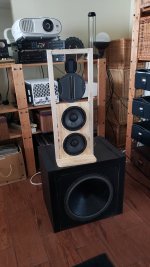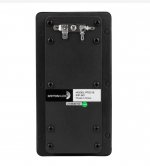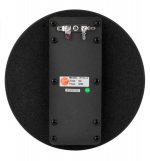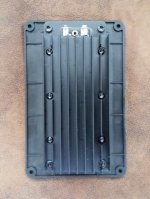I had exactly opposite experience. Recently started rebuilding mtm to mmtt, and had 2nd order filters all over, did not like the sound. Was sterile like typical commercial speakers. I thing higher the crossover order, bigger phase mess, even if it measures flat on axis.
Long story short, i removed 2nd order, now its just an inductor for mids, one cap for hivi, one cap for foster supertweet.
Measures flat on axis, and off axis till 40deg. Flat phase. Low distortion by rew. Very musical. No sign if harshness from the hivi planar.
But i do not listen loud.
Cosmetics is work in progress, it sounded great upstairs, so i had to test it in bigger room with best amps.
Long story short, i removed 2nd order, now its just an inductor for mids, one cap for hivi, one cap for foster supertweet.
Measures flat on axis, and off axis till 40deg. Flat phase. Low distortion by rew. Very musical. No sign if harshness from the hivi planar.
But i do not listen loud.
Cosmetics is work in progress, it sounded great upstairs, so i had to test it in bigger room with best amps.
Attachments
Here is discussion on parts express forum, people discussing crossing it at 2500 and even 2000 Hz, offcourse with higher degree crossover.Will the RT2C-A handle a 6 dB crossover that low? I used a pair in a 3 way and couldn't cross them lower than about 5k 2nd order without excess roughness in the mids. I ended up at 6k 2nd order and the sound was really nice and open.
5kHz was selected because that 6fe200 naturally rolls of. Crossing higher may create gap.
Out of two dozen speakers i have, i like the ones with simple crossover most. Ideally nothing on mid, just a cap for tweeter. If they behave.
I am even thinking about removing the coil next.
https://www.parts-express.com/HiVi-RT2C-A-Planar-Isodynamic-Tweeter-297-406
Just bypassed the coil for two 6fe200. Will listen.
Placed digital oscope on the satellite, average level 200mV rms, with peaks to 500mV.
This is for the two midranges and tweeters together. Fraction goes to hivi. This is like 1/10th of the watt at normal listening level. With 70 watts of music power handling, i think i am safe.
Not sure how you managed to get it to distort. It has 94dB sensitivity, you must have been pushing 100 watts just to the poor planar. Are you sure it was not the midrange, or better, amplifier which was distorting? Or worse, clipping?
Placed digital oscope on the satellite, average level 200mV rms, with peaks to 500mV.
This is for the two midranges and tweeters together. Fraction goes to hivi. This is like 1/10th of the watt at normal listening level. With 70 watts of music power handling, i think i am safe.
Not sure how you managed to get it to distort. It has 94dB sensitivity, you must have been pushing 100 watts just to the poor planar. Are you sure it was not the midrange, or better, amplifier which was distorting? Or worse, clipping?
5k 2nd order you had excess roughness...Will the RT2C-A handle a 6 dB crossover that low? I used a pair in a 3 way and couldn't cross them lower than about 5k 2nd order without excess roughness in the mids. I ended up at 6k 2nd order and the sound was really nice and open.
6k 2nd order sound was really nice and open...
With caps often +/- 10% spec, this seems highly questionable.
Can you post pictures of your built? Measurements of fr response with distortion before and after the change?
That's interesting. This build was roughly 10 yrs ago, so I dont have pics. It was a 3 way WMTM with RT2C-A, 2x Audax MH100ZO mids and Audax PR330MO LF. It was designed to play loud for a guy who listened to alot of big band jazz. Is it possible my batch of RT2CAs was a different spec at that time? Thats really the only explanation I can think of given our different experiences.
Not to pull this off topic, but an interesting observation with these planar tweeters - looking at the pics on PEs website, I'm noticing something - if you look at the Hivi RT2C-A, RT2H-A (not pictured) and the Dayton PT2C-8, you will see the drive element is suspiciously the same on all three. The specs also look similar. I also have a pair of PHT1-6s that also use a similar type of drive element, but this one is 6 ohms (not 8 ohms like the three others). Its also rated for more power and i believe thats due to a thicker conductive layer on the diaphragm, including the added heatsink. The drive elements on all 4 of these tweeters is the same size.
What I'm getting at is there was a production change in the drive element on the HIvi tweeters. I bought some of the older version/ brand of PT2C-8 and later purchased more, which sounded different (not as open and airy). I also noticed some reviews stating the same observations, which also included the RT2C-A. Since then I didn't use these tweeters anymore based on those findings. The exception is the PHT1-6, which is a beast of a planar, but it needs some eq on top to flatten the upper end drop off. The waveguide makes it more efficient, but suffers from early HF rolloff.
Have you observed anything similar?
What I'm getting at is there was a production change in the drive element on the HIvi tweeters. I bought some of the older version/ brand of PT2C-8 and later purchased more, which sounded different (not as open and airy). I also noticed some reviews stating the same observations, which also included the RT2C-A. Since then I didn't use these tweeters anymore based on those findings. The exception is the PHT1-6, which is a beast of a planar, but it needs some eq on top to flatten the upper end drop off. The waveguide makes it more efficient, but suffers from early HF rolloff.
Have you observed anything similar?
Attachments
Specific answer to the question is at 5k 2nd order HP there was some distortion from what sounded like the diaphragm bottoming out or buzzing. This was solved by moving the xover up a little. I always match my crossover components to 1% both sides, but not to target spec, so there may have been some error up or down. Also, back 10+ yrs ago when these speakers were designed, I was still using pink noise and a 1/3rd octave analyzer to design crossovers including lots of listening (yes, I was old school and still am a bit now).5k 2nd order you had excess roughness...
6k 2nd order sound was really nice and open...
With caps often +/- 10% spec, this seems highly questionable.
Can you post pictures of your built? Measurements of fr response with distortion before and after the change?
Not to pull this off topic, but an interesting observation with these planar tweeters - looking at the pics on PEs website, I'm noticing something - if you look at the Hivi RT2C-A, RT2H-A (not pictured) and the Dayton PT2C-8, you will see the drive element is suspiciously the same on all three. The specs also look similar. I also have a pair of PHT1-6s that also use a similar type of drive element, but this one is 6 ohms (not 8 ohms like the three others). Its also rated for more power and i believe thats due to a thicker conductive layer on the diaphragm, including the added heatsink. The drive elements on all 4 of these tweeters is the same size.
What I'm getting at is there was a production change in the drive element on the HIvi tweeters. I bought some of the older version/ brand of PT2C-8 and later purchased more, which sounded different (not as open and airy). I also noticed some reviews stating the same observations, which also included the RT2C-A. Since then I didn't use these tweeters anymore based on those findings. The exception is the PHT1-6, which is a beast of a planar, but it needs some eq on top to flatten the upper end drop off. The waveguide makes it more efficient, but suffers from early HF rolloff.
Have you observed anything similar?
Interesting.
Now you know why i put supertweeter on top.
My rt2c-a are very old, i bought them long time ago.
I am happy with the sound, and starting some painting. Sound first, looks later.
I see you used that buyout ribbon from PE. How do you like it and does it match up well to the larger one?
For $14 it beats $300 fostex supertweeters.I see you used that buyout ribbon from PE. How do you like it and does it match up well to the larger one?
I will try to find posts about it...
https://www.diyaudio.com/community/threads/foster-e100t10-ribbons-what-quality.113262/post-6738936
I've used a few foster (fostex) ribbons as well as the Panasonic/Technics TH400 and TH800. I'd say for the money this little planar can't be beat and likely has low distortion past 5k. I wish it didn't have such an ugly faceplate setup. I guess it doesn't matter if you back mount it with a flare in front of it. I wonder what the optimal flare geometry would be to get a fairly flat FR.
I saw your thread with the small array. Looks interesting and I'd be curious if you had a thd measurement on that little foster planar.
Hard to get for supertweeter..second harmonic for 10kHz is 20kHz, third is 30kHz.
Way above my audio measurement.
Way above my audio measurement.
It sounds exceptionaly clean to me. I believe it has very low distortion. I use cd with chimes recorded, loud and clear, which tests audio system upper limit to the max. It sounds like chimes right there in the room. Crystal clear.
Distortion is critical to me that high, especially amplifier.
Distortion is critical to me that high, especially amplifier.
As a matter of fact, from about 50 amplifiers I have, I rank them by the performance at high frequencies. Besides the soundstage.
Similarly, with two dozen of the speakers I built, the ones I like the most are the ones with best tweeters.
Similarly, with two dozen of the speakers I built, the ones I like the most are the ones with best tweeters.
- Home
- Loudspeakers
- Multi-Way
- 6FE200 + ST200



